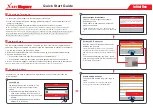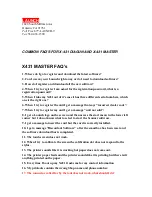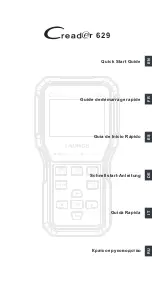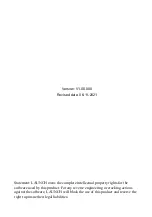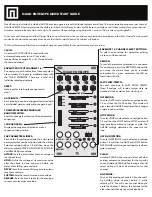
442
Agilent 6000 Series Oscilloscopes Programmer's Reference
3
Commands by Subsystem
on page 448) provides 16- bit
access to the waveform data. In the WORD format, the number of data
bytes is twice the number of data points. The number of data points is
the value returned by the :WAVeform:POINts? query (see
). If
the data intrinsically has less than 16 bits of resolution, the data is
left- shifted to provide 16 bits of resolution and the least significant bits
are set to 0. Currently, the greatest intrinsic resolution of any data is
12 bits, so at least the lowest 4 bits of data will be 0. If there is a hole
in the data, the hole is represented by a 16 bit value equal to 0.
Use :WAVeform:BYTeorder (see
) to determine if the least
significant byte or most significant byte is to be transferred first. The
:BYTeorder command can be used to alter the transmit sequence to
match the storage sequence of an integer in the programming language
being used.
Data Format for Transfer - BYTE format
The BYTE format (see
on page 448 ) allows 8- bit
access to the waveform data. If the data intrinsically has more than 8
bits of resolution (averaged data), the data is right- shifted (truncated)
to fit into 8 bits. If there is a hole in the data, the hole is represented
by a value of 0. The BYTE- formatted data transfers over the GPIB
faster than ASCii or WORD- formatted data, because in ASCii format, as
many as 13 bytes per point are transferred, in BYTE format one byte
per point is transferred, and in WORD format two bytes per point are
transferred.
The :WAVeform:BYTeorder command (see
) has no effect when
the data format is BYTE.
Digital Channel Data (MSO models only)
The waveform record for digital channels is similar to that of analog
channels. The main difference is that the data points represent either
DIGital0,..,7 (POD1), DIGital8,..,15 (POD2), or any grouping of digital
channels (BUS1 or BUS2).
For digital channels, :WAVeform:UNSigned (see
) must be set to
ON.
Digital Channel POD Data Format
Data for digital channels is only available in groups of 8 bits (Pod1 = D0 -
D7, Pod2 = D8 - D15). The bytes are organized as:
:WAVeform:SOURce
Bit 7
Bit 6
Bit 5
Bit 4
Bit 3
Bit 2
Bit 1
Bit 0
POD1
D7
D6
D5
D4
D3
D2
D1
D0
POD2
D15
D14
D13
D12
D11
D10
D9
D8
Содержание DSO6014A/L
Страница 1: ...A Agilent 6000 Series Oscilloscopes Programmer s Reference...
Страница 16: ...16 Agilent 6000 Series Oscilloscopes Programmer s Reference...
Страница 30: ...30 Agilent 6000 Series Oscilloscopes Programmer s Reference 1 What s New...
Страница 540: ...540 Agilent 6000 Series Oscilloscopes Programmer s Reference 6 Error Messages...
Страница 562: ...562 Agilent 6000 Series Oscilloscopes Programmer s Reference 7 Status Reporting...
Страница 584: ...584 Agilent 6000 Series Oscilloscopes Programmer s Reference 8 More About Oscilloscope Commands...
Страница 624: ...624 Agilent 6000 Series Oscilloscopes Programmer s Reference 9 Programming Examples...





































